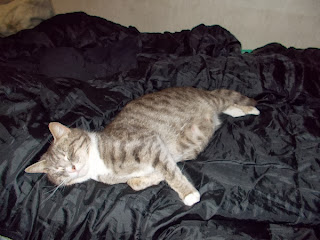We were recently adopted by a local stray, who we quickly realised was pregnant. So over the next four weeks we stuffed her with food and won her affections forever.
We were a bit worried about her having her kittens outside, so encouraged her into the house. This paid off... unexpectedly well.
A few hours before giving birth. Jess was having contractions and being super clingy, complaining loudly if she wasn't getting stroked right that second.
Here you can see a video of her contractions.
She disappeared under the bed and settled down silently, only for me to be woken by what seemed to be a bird at about 4.30am as the first kitten was born.
The Birth
You can hear one of the newborn kittens crying in this video (literally newborn. The mother hadn't even started washing it yet).
It was pretty dark under the bed, so I had to use the flash, so I only took occasional pictures. The whole thing took about two and a half hours, each kitten popping neatly out about 20-40 minutes apart, followed by the placentas (which I never saw).
Jess is expelling the placenta while the first kitten snuggles into her and the second rests between her hind legs.
Washing the third kitten, while the others get confused about where their mum is (I managed to sneak more newspaper in, not that it did any good).
The third kitten, all pink and patchy snuggles up with its siblings.
Four kittens!
Day Zero
Later in the day, the kittens are already looking more like kittens.
And the mother is very happy.
And even happier to see food.
She stayed in here for over a day.
Jumping up for food, to the dismay of her babies.
Then settling back down with them.
Day One
She actually comes right out looking for food, though she kept checking on her kittens behind her, and wouldn't let me stroke her.
The kittens are sleeping, and didn't really notice.
Back in to lick them clean some more (and eat the kitten poop).
The evening of the second day, we moved the kittens. I scooped them all into a basket (after lifting up the whole mattress!), and walked them slowly down to their new spot, letting their mother see them - but not grab them back!
She was a little confused, but pretty good about it. The basket was the minimise the disruption and reduce the risk of getting human scent all over the babies.
After a brief escape with one kitten before we had them settled (easily fixed, as I just went and picked it up and it mewed its mother back down the hallway), Jess decides that her new home is perfect. It's a small table covered in blankets.
She settles right down to feed her babies.
Purring the whole time.
And then she realised that her babies were trapped in a basket and promptly went wandering around the house begging for attention, and made her first trip back outside (to poop, presumably).
Day Two
The kittens are doing well in their basket, and the mother is very much enjoying her new freedom and a steady supply of food and water.
But she's being very good about feeding them regularly.
Carefully sitting down and sort of wiggling and rearranging herself while the kittens move out of the way.
And then lying down and purring happily as they figure out how to find the nipples.
Feeding usually takes around ten or fifteen minutes, as the various kittens manage to drink.
And then they go to sleep.
(I actually picked up the basket to put it under the window to get a better photo for this one. Jess was quite happy about it).
Poor old Moss (who's been feeling a bit rickety) has been hissed at a couple of times, when she went to poke her nose in to see what the kittens were, and half the house is off limits to her now.
But she's coping with it pretty well.
Day Three
The kittens are a bit livelier and don't spend the whole time burying their faces in each other now, so I managed to get a few photos of them.
I even got this video of them burrowing into each other.
Kittens in motion!
Snuggled up against the side of the basket
Whoops! The dark grey tabby just fell right off the pile!
Here they've lined up nicely. So we have two calicos (almost certainly female) and two mysteriously gendered greys.












































